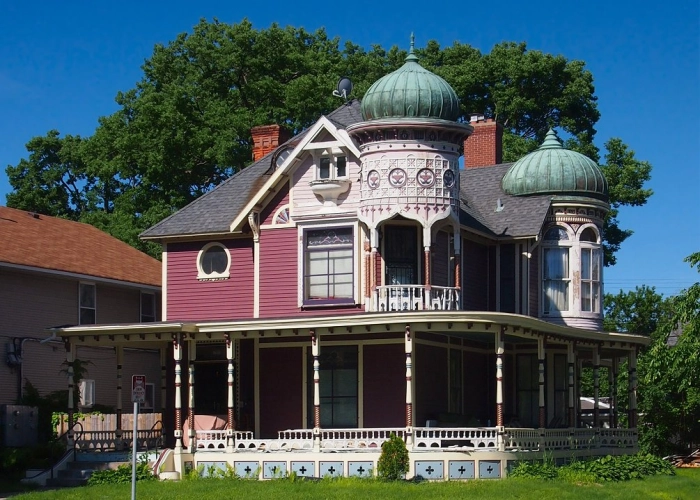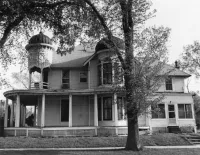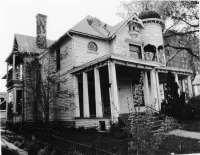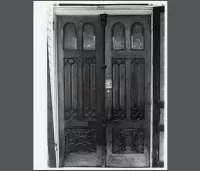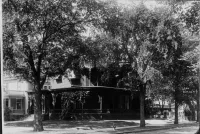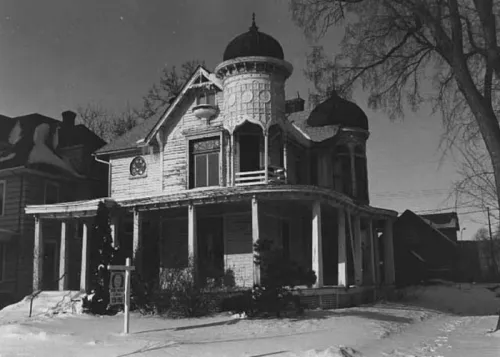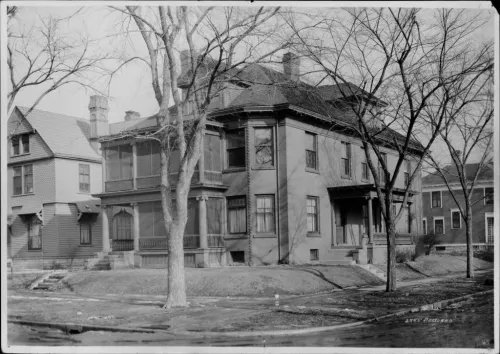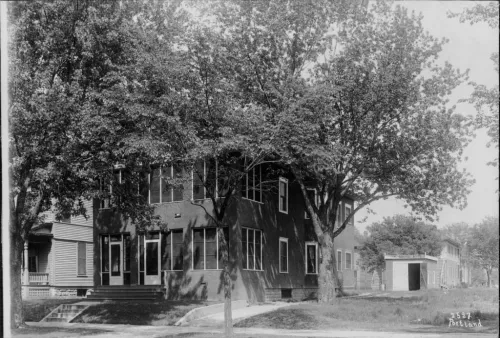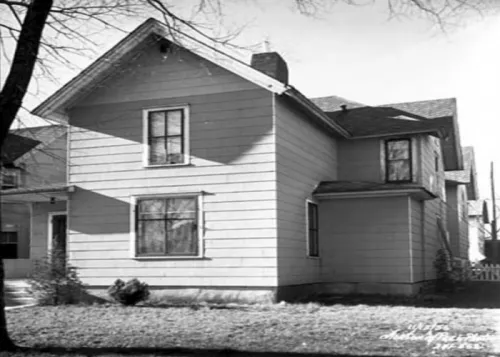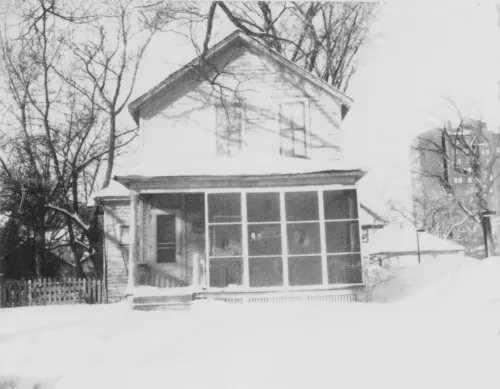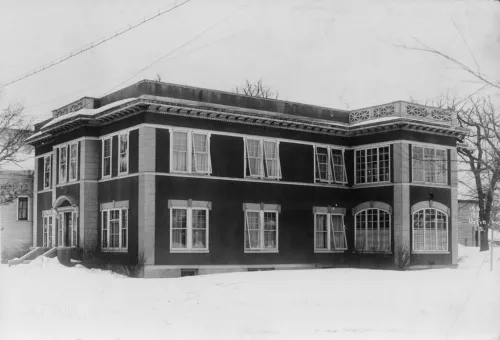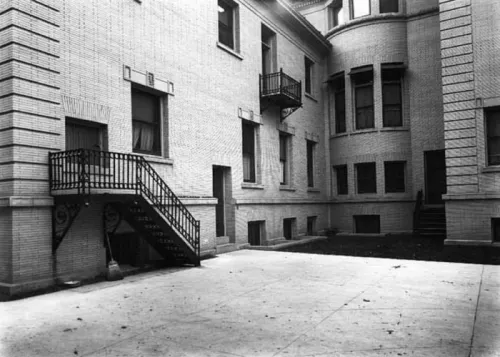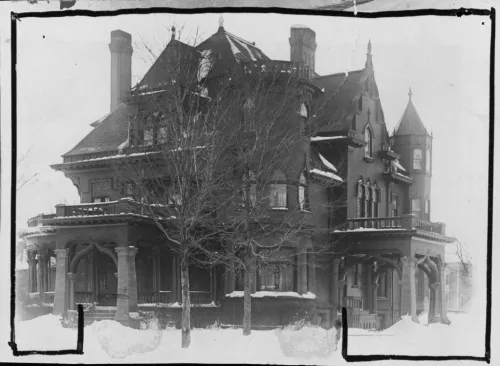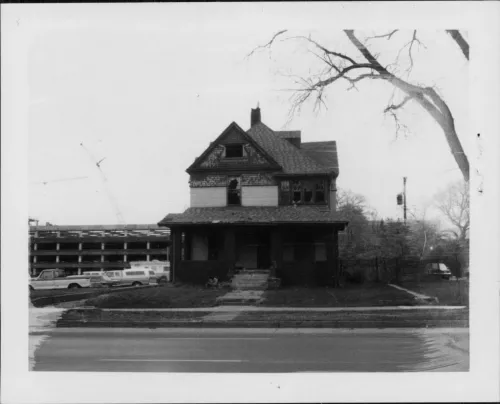Share what you know,
and discover more.
Share what you know,
and discover more.
Mar 28, 2021
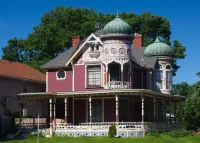
-

- Dave D
The Bardwell–Ferrant House
From Wikipedia: The Bardwell–Ferrant House is a house in the Phillips West neighborhood of Minneapolis, Minnesota, United States. It was built in 1883 at 1800 Park Avenue for its first owner, Charles Bardwell, and its original plan was in the Queen Anne style. In 1890 its second owner, Emil Ferrant, had the house remodeled in the Moorish Revival style that was popular at the time. Norwegian-born architect Carl F. Struck added two onion-domed towers, a wraparound porch with spindlework columns, ogee arches, and deep-toned stained glass windows. The house was later moved to its present location at 2500 Portland Ave. S. in 1898 to make way for a bank building. The house was listed on the National Register of Historic Places in 1984. It was nominated based on it being a locally significant example of the late 19th-century interest in exotic revival architecture. Architect Carl Struck was the only Norwegian-born architect who practiced this style in Minneapolis. Struck was also responsible for designing Dania Hall in 1885, which was listed on the National Register in 1974 but destroyed by fire in 2000. There were few buildings originally built in the Moorish Revival style; the usual practice was to apply these forms to structures built in simpler styles. The Bardwell-Ferrant house is an unusually picturesque representative of this practice, making it locally significant.[4] In 1986 partners Mary Lou Maxwell and Jean Steward bought the house and renovated it, subdividing it into four apartments. At the time, the house was structurally sound, but significant mechanical work was required, including new heating, electrical, and plumbing systems. Thieves had also stolen some of the stained glass windows and tile from the fireplace mantels. After the renovation, three of the four apartments had two stories, and all were outfitted with new appliances. Much of the siding on the exterior was replaced, and it was repainted in a mauve color (the Victorian term for this color was "ashes of roses"). The trim was painted in a cream color, and the pressed metal trim on the towers was painted with other colors to complement the stained glass windows. The home was sold again in 2001 and later fell into foreclosure. In 2011 a new owner purchased the home with an eye toward restoring the house to a single-family home. During the period of foreclosure, the home suffered from vandalism and damage including structural issues, several fireplace mantels that had been pried away from the walls, damage to several of the stained glass windows, and theft of some of the homes copper pipe and wiring.
The Bardwell–Ferrant House
From Wikipedia: The Bardwell–Ferrant House is a house in the Phillips West neighborhood of Minneapolis, Minnesota, United States. It was built in 1883 at 1800 Park Avenue for its first owner, Charles Bardwell, and its original plan was in the Queen Anne style. In 1890 its second owner, Emil Ferrant, had the house remodeled in the Moorish Revival style that was popular at the time. Norwegian-born architect Carl F. Struck added two onion-domed towers, a wraparound porch with spindlework columns, ogee arches, and deep-toned stained glass windows. The house was later moved to its present location at 2500 Portland Ave. S. in 1898 to make way for a bank building. The house was listed on the National Register of Historic Places in 1984. It was nominated based on it being a locally significant example of the late 19th-century interest in exotic revival architecture. Architect Carl Struck was the only Norwegian-born architect who practiced this style in Minneapolis. Struck was also responsible for designing Dania Hall in 1885, which was listed on the National Register in 1974 but destroyed by fire in 2000. There were few buildings originally built in the Moorish Revival style; the usual practice was to apply these forms to structures built in simpler styles. The Bardwell-Ferrant house is an unusually picturesque representative of this practice, making it locally significant.[4] In 1986 partners Mary Lou Maxwell and Jean Steward bought the house and renovated it, subdividing it into four apartments. At the time, the house was structurally sound, but significant mechanical work was required, including new heating, electrical, and plumbing systems. Thieves had also stolen some of the stained glass windows and tile from the fireplace mantels. After the renovation, three of the four apartments had two stories, and all were outfitted with new appliances. Much of the siding on the exterior was replaced, and it was repainted in a mauve color (the Victorian term for this color was "ashes of roses"). The trim was painted in a cream color, and the pressed metal trim on the towers was painted with other colors to complement the stained glass windows. The home was sold again in 2001 and later fell into foreclosure. In 2011 a new owner purchased the home with an eye toward restoring the house to a single-family home. During the period of foreclosure, the home suffered from vandalism and damage including structural issues, several fireplace mantels that had been pried away from the walls, damage to several of the stained glass windows, and theft of some of the homes copper pipe and wiring.
Mar 28, 2021
The Bardwell–Ferrant House
From Wikipedia:The Bardwell–Ferrant House is a house in the Phillips West neighborhood of Minneapolis, Minnesota, United States. It was built in 1883 at 1800 Park Avenue for its first owner, Charles Bardwell, and its original plan was in the Queen Anne style. In 1890 its second owner, Emil Ferrant, had the house remodeled in the Moorish Revival style that was popular at the time. Norwegian-born architect Carl F. Struck added two onion-domed towers, a wraparound porch with spindlework columns, ogee arches, and deep-toned stained glass windows. The house was later moved to its present location at 2500 Portland Ave. S. in 1898 to make way for a bank building.
The house was listed on the National Register of Historic Places in 1984. It was nominated based on it being a locally significant example of the late 19th-century interest in exotic revival architecture. Architect Carl Struck was the only Norwegian-born architect who practiced this style in Minneapolis. Struck was also responsible for designing Dania Hall in 1885, which was listed on the National Register in 1974 but destroyed by fire in 2000. There were few buildings originally built in the Moorish Revival style; the usual practice was to apply these forms to structures built in simpler styles. The Bardwell-Ferrant house is an unusually picturesque representative of this practice, making it locally significant.[4]
In 1986 partners Mary Lou Maxwell and Jean Steward bought the house and renovated it, subdividing it into four apartments. At the time, the house was structurally sound, but significant mechanical work was required, including new heating, electrical, and plumbing systems. Thieves had also stolen some of the stained glass windows and tile from the fireplace mantels. After the renovation, three of the four apartments had two stories, and all were outfitted with new appliances. Much of the siding on the exterior was replaced, and it was repainted in a mauve color (the Victorian term for this color was "ashes of roses"). The trim was painted in a cream color, and the pressed metal trim on the towers was painted with other colors to complement the stained glass windows.
The home was sold again in 2001 and later fell into foreclosure. In 2011 a new owner purchased the home with an eye toward restoring the house to a single-family home. During the period of foreclosure, the home suffered from vandalism and damage including structural issues, several fireplace mantels that had been pried away from the walls, damage to several of the stained glass windows, and theft of some of the homes copper pipe and wiring.
Posted Date
Feb 04, 2022
Historical Record Date
Mar 28, 2021
Source Name
Wikipedia
Source Website
https://en.wikipedia.org/wiki/Bardwell%E2%80%93Ferrant_House
Delete Story
Are you sure you want to delete this story?
Oct 01, 2008
Oct 01, 2008
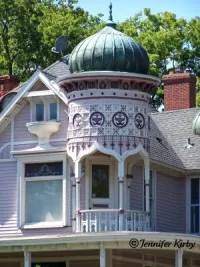
-

- Marley Zielike
Exotic For Sale Minneapolis Historic Homes
I hear these words ring through my head as I drive by 2500 Portland Avenue in Minneapolis. A big fan of the Back to the Future trilogy, I cant help but feel the need to scream Save the Clock Tower, or in this case, save a rare piece of architectural history from neglect. Yes, this Moorish home is located in a not so good part of town, but is there anyone out there willing to take the risk and save this historic home from further decay and vandalism? As a real estate agent, I know that in todays market, the buying of a home comes down to price for most people. When this home was first placed on the market as a foreclosure by Automated Realty , it was priced at $229,900, well below the 2006 purchase price of $385,000. It has recently been reduced to $208,900. But the location of the home is the main culprit for its lack of appeal. If it were located in Ramsey Hill of Saint Paul, or near the Minneapolis chain of lakes, the home would have sold in no time at all. So is it any wonder that there are no takers? Built in 1883 by Charles Bardwell , the original design was as a Queen Anne Victorian and was located on a different site at 1800 Park Avenue . However when the new owner, Emil Ferrant, purchased the home in 1890, he had Moorish features added to the home which can easily be seen in the onion domes. It is now simply known as the Bardwell-Ferrant House and was registered on the National Registry of Historic Places in 1984. Before the home was bought and renovated in 1986 by Rolf Lokensgard, the once beautiful historic home was in disrepair . About $160,000 in renovations were put into the home and you can find stories about the renovation on other blogs . Please, someone, buy this house and save it!
Exotic For Sale Minneapolis Historic Homes
I hear these words ring through my head as I drive by 2500 Portland Avenue in Minneapolis. A big fan of the Back to the Future trilogy, I cant help but feel the need to scream Save the Clock Tower, or in this case, save a rare piece of architectural history from neglect. Yes, this Moorish home is located in a not so good part of town, but is there anyone out there willing to take the risk and save this historic home from further decay and vandalism? As a real estate agent, I know that in todays market, the buying of a home comes down to price for most people. When this home was first placed on the market as a foreclosure by Automated Realty , it was priced at $229,900, well below the 2006 purchase price of $385,000. It has recently been reduced to $208,900. But the location of the home is the main culprit for its lack of appeal. If it were located in Ramsey Hill of Saint Paul, or near the Minneapolis chain of lakes, the home would have sold in no time at all. So is it any wonder that there are no takers? Built in 1883 by Charles Bardwell , the original design was as a Queen Anne Victorian and was located on a different site at 1800 Park Avenue . However when the new owner, Emil Ferrant, purchased the home in 1890, he had Moorish features added to the home which can easily be seen in the onion domes. It is now simply known as the Bardwell-Ferrant House and was registered on the National Registry of Historic Places in 1984. Before the home was bought and renovated in 1986 by Rolf Lokensgard, the once beautiful historic home was in disrepair . About $160,000 in renovations were put into the home and you can find stories about the renovation on other blogs . Please, someone, buy this house and save it!
Exotic For Sale Minneapolis Historic Homes
I hear these words ring through my head as I drive by 2500 Portland Avenue in Minneapolis. A big fan of the Back to the Future trilogy, I cant help but feel the need to scream Save the Clock Tower, or in this case, save a rare piece of architectural history from neglect. Yes, this Moorish home is located in a not so good part of town, but is there anyone out there willing to take the risk and save this historic home from further decay and vandalism? As a real estate agent, I know that in todays market, the buying of a home comes down to price for most people. When this home was first placed on the market as a foreclosure by Automated Realty , it was priced at $229,900, well below the 2006 purchase price of $385,000. It has recently been reduced to $208,900. But the location of the home is the main culprit for its lack of appeal. If it were located in Ramsey Hill of Saint Paul, or near the Minneapolis chain of lakes, the home would have sold in no time at all. So is it any wonder that there are no takers? Built in 1883 by Charles Bardwell , the original design was as a Queen Anne Victorian and was located on a different site at 1800 Park Avenue . However when the new owner, Emil Ferrant, purchased the home in 1890, he had Moorish features added to the home which can easily be seen in the onion domes. It is now simply known as the Bardwell-Ferrant House and was registered on the National Registry of Historic Places in 1984. Before the home was bought and renovated in 1986 by Rolf Lokensgard, the once beautiful historic home was in disrepair . About $160,000 in renovations were put into the home and you can find stories about the renovation on other blogs . Please, someone, buy this house and save it!Posted Date
Sep 27, 2021
Historical Record Date
Oct 01, 2008
Source Name
Historic Homes of Minnesota
Delete Story
Are you sure you want to delete this story?
Aug 09, 1984
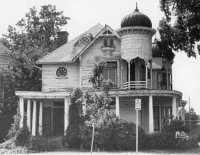
-

- Dave D
National Register of Historic Places
Statement of Significance: The Bardwell-Ferrant House is architecturally significant as a locally distinctive example of the national Interest in exotic themes in the late nineteenth century. Constructed about 1883 for Charles Bardwell, the house was originally located at 1800 Park Avenue and was moved to its present site in 1898 to make way for the construction of an apartment building. The original simple Queen Anne form of the dwelling was transformed in 189O into a Moorish fantasy by the addition of onion-domed towers, ogee arch shapes, and deep-toned stained glass lights. Emil Ferrant engaged locally prominent architect Carl F. Struck who created the Moorish design theme for the house. Struck was the only Norwegian native architect in the 19th century to practice his craft in Minneapolis and was responsible for the design of Dania Hall, 1885 (National Register 1974). Few local buildings were constructed in the Moorish mode; rather, the exotic forms were added to otherwise simple structures. The Bardwel1- Ferrant House is an unusually picturesque representative of exotic forms applied to traditional architectural styles and, as such, is an important asset to the community.
National Register of Historic Places
Statement of Significance: The Bardwell-Ferrant House is architecturally significant as a locally distinctive example of the national Interest in exotic themes in the late nineteenth century. Constructed about 1883 for Charles Bardwell, the house was originally located at 1800 Park Avenue and was moved to its present site in 1898 to make way for the construction of an apartment building. The original simple Queen Anne form of the dwelling was transformed in 189O into a Moorish fantasy by the addition of onion-domed towers, ogee arch shapes, and deep-toned stained glass lights. Emil Ferrant engaged locally prominent architect Carl F. Struck who created the Moorish design theme for the house. Struck was the only Norwegian native architect in the 19th century to practice his craft in Minneapolis and was responsible for the design of Dania Hall, 1885 (National Register 1974). Few local buildings were constructed in the Moorish mode; rather, the exotic forms were added to otherwise simple structures. The Bardwel1- Ferrant House is an unusually picturesque representative of exotic forms applied to traditional architectural styles and, as such, is an important asset to the community.
Aug 09, 1984
National Register of Historic Places
Statement of Significance:The Bardwell-Ferrant House is architecturally significant as a locally distinctive example of the national Interest in exotic themes in the late nineteenth century. Constructed about 1883 for Charles Bardwell, the house was originally located at 1800 Park Avenue and was moved to its present site in 1898 to make way for the construction of an apartment building. The original simple Queen Anne form of the dwelling was transformed in 189O into a Moorish fantasy by the addition of onion-domed towers, ogee arch shapes, and deep-toned stained glass lights. Emil Ferrant engaged locally prominent architect Carl F. Struck who created the Moorish design theme for the house. Struck was the only Norwegian native architect in the 19th century to practice his craft in Minneapolis and was responsible for the design of Dania Hall, 1885 (National Register 1974). Few local buildings were constructed in the Moorish mode; rather, the exotic forms were added to otherwise simple structures. The Bardwel1- Ferrant House is an unusually picturesque representative of exotic forms applied to traditional architectural styles and, as such, is an important asset to the community.
Posted Date
Feb 04, 2022
Historical Record Date
Aug 09, 1984
Source Name
United States Department of the Interior - National Park Service
Document Source
Source Website
Delete Story
Are you sure you want to delete this story?
Oct 01, 1930
Oct 01, 1930
Houses
Posted Date
Sep 27, 2021
Historical Record Date
Oct 01, 1930
Source Name
Hennepin History Museum Collections
Delete Story
Are you sure you want to delete this story?
